Porchetta is perfect. Crackling crisp skin, self-basting pork roast and a magical mélange of fennel, pepper and lemon. It’s no surprise that at some point, someone thought to try and turn turkey (one of Mother Earth’s slights if there ever was one), into this heavenly treasure. But I was perplexed: Reasonable people can agree turkey breast becomes dry and tasteless all too easy. How could this bird—the driest part of it, to boot—result in anything that resembled what is arguably the best version of pork available to mankind without the addition of some fat? Indeed, this recipe was not porchetta, but a simple roulade. So off I went to make it both more delicious and more complicated.
Since my favorite porchetta recipes are often stuffed with sausage, I decided to take the confit that many people are making with the turkey dark meat and use that in my “turchetta” (it’s the last time I’ll use that word, I promise). The duck fat I’d make the confit with would baste the roast and give it more, well, everything. And friends: Unlike some experiments in the past, this one is worth the ride.
Breaking down the bird
Table of Contents
You can just buy a bone-in breast with the skin on and pick up a leg or two to make the confit, but by breaking down a whole bird yourself, you will get one perfect, unbroken piece of turkey skin from tip to tail—an important part of this recipe. The first step is to take the skin off the bird, trying to keep as much of it intact as possible. This includes the legs and thighs.
Slice through the skin where the legs meet the cutting board to get it started and then use your fingers to separate the skin from the meat by sliding under the skin along the meat, breaking through any resistance. If you need to, cut it free from the meat with a knife in particularly stubborn places, but you shouldn’t need the assist. Again, the goal here is to get as large a piece as possible.
Once the skin is free, put it into a ziplock bag, remove as much air as possible, and place it in the fridge to chill out. Twist the legs away from the breast until they pop away, and then use your knife to break them free of the bird and put them into a vacuum bag. Cut the breasts away from the bone, using the tip of your knife and shallow cuts along the bone. You should end up with a mirror image of each half. Cut away the nugget piece (that extra flap hanging off the breast), and clean up the breasts as needed (remove fat or any imperfections).
You’ll be left with the rest of the bird, aside from the legs, and all of it is extra and unneeded, so make some stock and enjoy some soup while this recipe progresses.

Line your cutting board with plastic wrap and lay the breasts on top of it. We need to get these to an even thickness, so you’re going to butterfly the top of each breast, which means you’ll make a diagonal slice into the meat, but not all the way through, so you can open the meat up like a book. Take your mallet and lightly pound the breasts from the middle out, to get them to an even thickness. If you don’t have a mallet, you can use a wine bottle (but this is an adult recipe—buy yourself a mallet, you’ve earned it). Your goal is to get the breasts into a rectangle. You want to slightly overlap the meat so there won’t be gaps when we roll it.
Season the meat
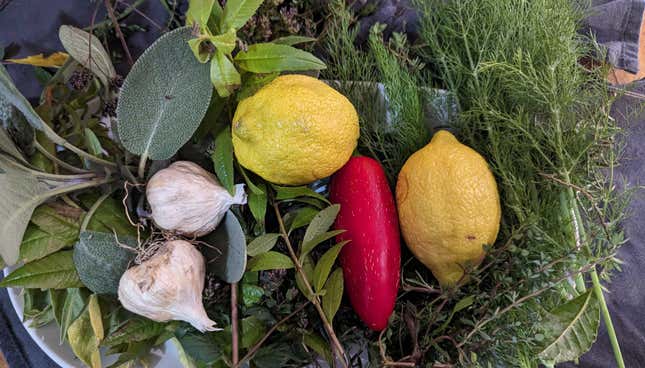
Because this is turkey, we’re going to season the ever-loving fuck out of it. You can start with dry herbs, but if you have fresh, all the better. I’ve provided amounts below, but there is no such thing as too much—so use more if you have it. Into a food processor, chuck your peppercorns, salt, rosemary, fennel, thyme, oregano, sage, lemon zest, an entire head’s worth of garlic cloves and half a jalapeño until you have a paste. Even if you don’t love spicy food, porchetta usually calls for red pepper flakes, and I found the addition of just half a jalapeño gave the meat only a mild kick, more notable for the spice than the heat. Trust.
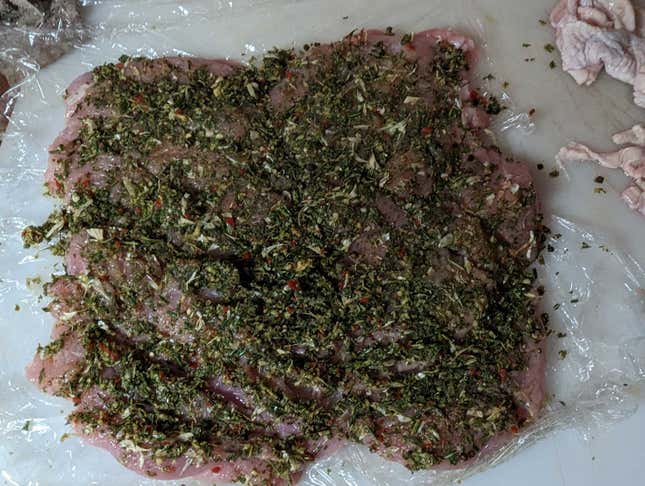
Cut a shallow cross hatch into the meat, 1/2 inch deep, and then distribute the seasoning and rub it into all the crevices.
Roll it and let it season
It’s time to roll, baby. We’re rolling along the longer side of the rectangle, and you should start from the less perfect of the two long sides, so that will be tucked inside the roll. Turn the cutting board so that side is closest to you. Roll the turkey tightly, using both hands, spaced evenly apart, rolling at the same time. Use the plastic as an assist to get started, if you need to, by picking up the edges, moving it away from you until the first roll of turkey meat is completed, and then just peel the plastic away and keep rolling. Once you’ve completely rolled the meat up, use the plastic to tightly wrap it up, twisting the ends tightly to make it more compact and tight. I carefully placed the completed roll into a vacuum bag for more security and then vacuum sealed it and placed it in the fridge for the next two days.
Make the confit
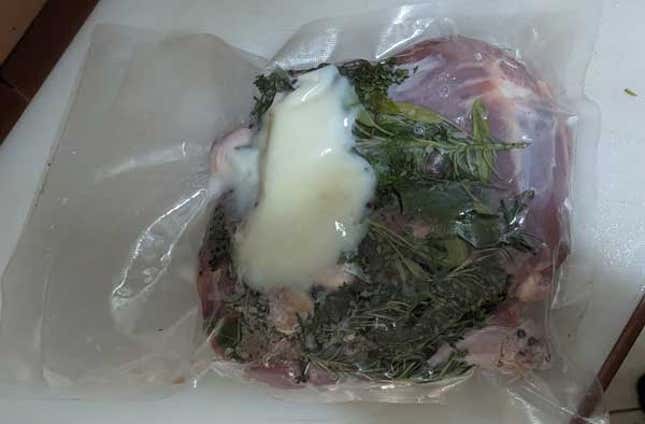
While the breast is chilling, we’re making some confit. To the bag with the leg (you really only need one, but hey, if you’re making confit, might as well chuck in all the dark meat), add two tablespoons of duck fat, a tablespoon of salt, a tablespoon of peppercorns and a nice handful of fresh thyme or two tablespoons of dry thyme, half a lemon and three large garlic cloves. Massage that into the legs, and then vacuum seal it and place it in the fridge to marinate for eight hours.
Next, sous vide the bag at 150F for 24 hours, then allow it chill out in the fridge for two to three hours.
Marry everything together
Prep your space—lay out a grid of twine on top of the cutting board, so you’ll be able to easily tie up the turkey roll once we’re done assembling. Remove the confit, and shred the meat from one of the legs, and use a spoon to remove five tablespoons of the aspic (the gelatin in the bag) and place it aside in a bowl. Remove anything in the aspic such as peppercorns or garlic, so it’s just the gelatin.
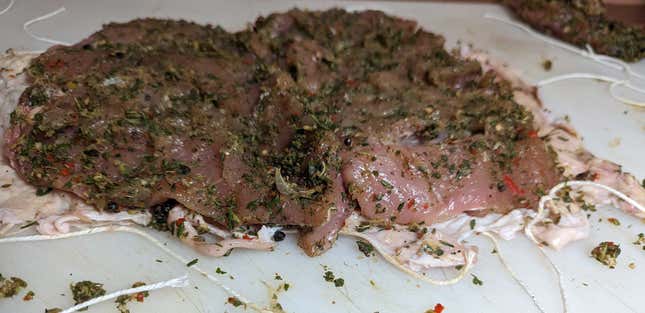
Take the turkey and skin out of the fridge. Start by laying the skin down on the grid of twine, with the outside of the skin facing down. Stretch the skin out as much as possible without tearing, into a nice big rectangle. It’s OK to cut the skin and use it to patch areas where there are tears or gaps by just overlaying it. Sprinkle the skin with salt and pepper.

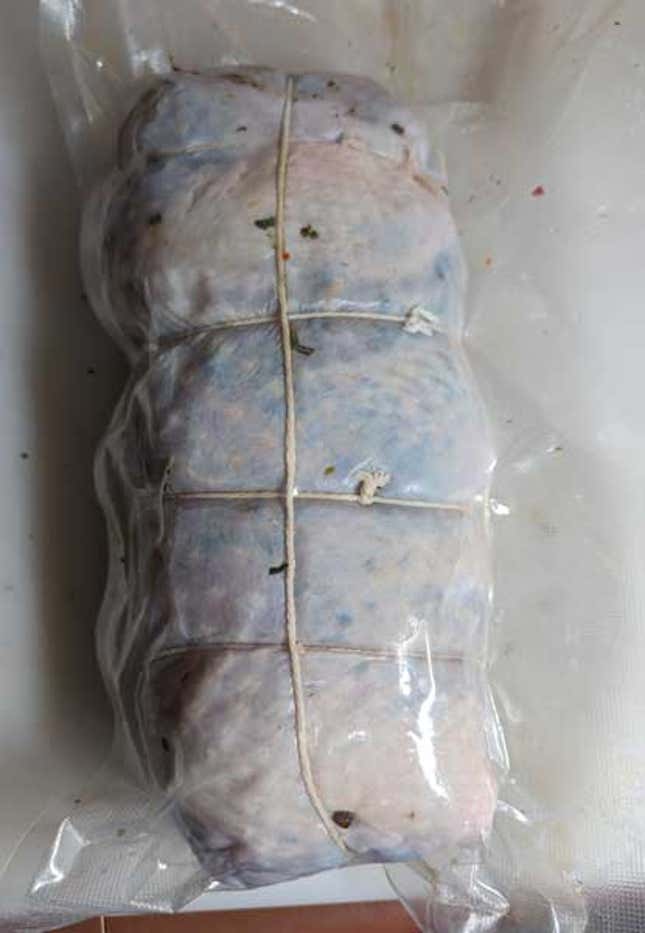
Now cut open the turkey roll, drain any juice in the bag out, and carefully unroll it on top of the skin, making the shapes, so the rectangles are facing the same way. On the half of the turkey that was the inside of the roll, lay your shredded confit on top, trying to distribute it evenly, then spoon the gelatin on top of the confit. You don’t need to spread it out—it will melt in the sous vide. Now we’re going to roll the turkey again, same as before, starting at the irregular side with the confit, but this time you’re taking the skin with you on the roll. Once you arrive at the end, use the twine to secure it in both directions, starting with the shorter pieces along the length, and then use at least two pieces of twine to secure it the long way, taking care to use the skin to cover the ends. You can’t over-secure it, so don’t worry about using too much twine. Trim the ends of the twine. Now carefully, so as to not disturb the skin, slide it into your vacuum bag and seal it.
Sous vide
This goes into a sous vide bath at 140F for four hours. When it comes out, place it in an ice bath for 10 minutes. Remove it from the bag, and use paper towels to dry it off. I placed it in front of a fan for 20 minutes just to really dry the skin out.
Crisp the skin
It’s time to deep fry, so prepare a pot or deep skillet or wok with at least two inches of oil, but be sure the dish is deep enough to accommodate the oil and the turkey porchetta so you don’t splash oil around when you add the turkey. Heat the oil to 400F, and then lower it to 300-350F. Carefully place the turkey into the pot. Be very careful around the pot, as oil may splatter. You’ll need to attend to it while cooking, just to ensure it doesn’t burn. It should stay on this side for eight to 10 minutes, until it is brown and crispy, and then carefully use your tongs to rotate it to the other side and repeat. While it is cooking, use a ladle to spoon oil over the top and sides, but do so very carefully so as to not splash it around. You’ll continue turning the turkey until all sides are brown and crispy, and if necessary, very carefully turn it on its end, holding it with the tongs, long enough to brown the ends. The turkey is already fully cooked, so the goal here is to just brown the sides and then get it out of the oil to rest. As soon as the sides are crispy, it’s done.
Plate it

Now just allow it to rest for 15 minutes and then use a very sharp chef or slicing knife to slice off one-inch sections to serve. Move the porchetta from the cutting board to the plate with a spatula so you preserve the look.
You could serve this with gravy, but I recommend a fruit sauce instead, like fermented cranberry sauce. This is a very rich dish, and the addition of acid will help lighten it. I served it with lemon, which juiced over the porchetta was very refreshing.
Because of the additional fat, this ended up being a very luxurious dish surprisingly full of flavor. There is an herbaceous, garlic undernote with a sweet heat from the pepper in the breast. The confit have a peppery silkiness, and when married together, they feel like the most luxurious paté en croute. When you get a bit of that crackling skin in the bite, it’s just an absolute baller. Sure, it’s a long ride, but we got there, didn’t we?
Turkey Porchetta with a confit stuffing
Ingredients
- 1 12-14 pound turkey, defrosted or one whole breast, bone in with skin and one turkey leg
- 1 ½ heads worth of garlic cloves, peeled
- 2 lemons plus 3 tablespoons of lemon zest
- 1 handful of fresh rosemary or 3 tablespoons of dry rosemary
- 1 handful of fresh sage or 3 tablespoons of dry sage
- 1 handful of fresh oregano or 3 tablespoons of dry oregano
- 1 handful of fresh fennel fronds or 3 tablespoons of dry fennel seeds
- 1 handful of fresh thyme sprigs or 2 tablespoons of dry thyme
- 1 jalapeño, either red or green
- 2 ½ tablespoon of peppercorns
- 2 ½ tablespoon of salt
- 3 tablespoons of duck fat
- Three cups of vegetable or peanut oil
Equipment
- Twine
- Sous vide machine
- Vacuum sealer or ziplock bags
- Pan or pot at least three inches deep
- Long tongs
- Plastic wrap
- Remove the skin from the turkey in as large a piece as possible. Place in a bag, with as little air as possible, and store in the refrigerator.
- Break the bird down into two boneless breasts, and the legs. The rest of the bird can be used for another project. Place the legs into a vacuum bag and set aside.
- On a plastic-wrap-lined cutting board, use the breasts to create a rectangle of meat. Butterfly thicker parts of the turkey breast as necessary, and use a mallet to otherwise gently shape the breasts into an even sheet of ½-inch-thick turkey. The breasts should slightly overlap to prevent gaps. Crosshatch the meat with shallow cuts.
- Combine the rosemary, sage, oregano, fennel, half the jalapeño, all but three of the garlic cloves, two tablespoons of the zest and one and a half tablespoons of the salt and peppercorns into a food processor and pulse until you have a paste. Rub this mixture into the turkey, getting into all the crevices.
- Roll the turkey up, the long way, starting with the more irregular side, into a cylindrical log. Use the plastic wrap to tightly wrap it, twisting the ends, and drop into a vacuum bag, and then vacuum it, and allow to rest for two days in the refrigerator.
- Add the duck fat, and remaining salt, pepper, garlic, zest and the thyme to the bag. Vacuum seal it and allow it to rest in the refrigerator overnight, for eight hours. Then sous vide it for 24 hours at 150 F. Allow the confit to rest in the refrigerator afterwards for two to three hours.
- Shred the meat of one leg, removing any bones, and place aside. Remove five tablespoons of aspic, clean it of any herbs, and set aside.
- Set up a grid of twine on a clean cutting board and lay the skin, outside down, on the grid, spreading it out as much as possible. Salt and pepper the skin lightly.
- Unroll the turkey breast on top of the skin, lining it up as much as possible. Add the shredded meat to the half of the roll that was on the inside (the first part to roll up). Distribute it evenly, and then spoon the aspic on top.
- Reroll the turkey, including the skin this time. Tie it up with the twine in both directions, making sure to cover the ends with the skin as well. Place the completed roll in a vacuum bag and then sous vide for four hours at 140 F.
- Place the roll, still in the bag, in an ice bath for five minutes, and then remove from the bag and dry the exterior with paper towels. Allow it to sit in front of a fan for a few minutes if possible to dry the exterior, while you bring a pot with the oil to 400F.
- Lower the pot temperature to 300-350F, and carefully add the roll to it, watching for spattering oil. Allow it to cook, attended, for eight to 10 minutes before turning the roll over and cooking until each side is crispy brown, but not burned. Continue turning until the entire exterior is crispy, ladleing oil over the top and sides as you go. If you’re comfortable doing so, use tongs to turn the roll on its side and holding it so just the end is in the oil, allowing it to crisp as well.
- Allow the finished roll to rest on a cutting board for 15 minutes before slicing into one-inch sections to serve. Transfer slices from the cutting board to the plate with a spatula to preserve the shape. Serve with a fruit- based or acidic sauce.
